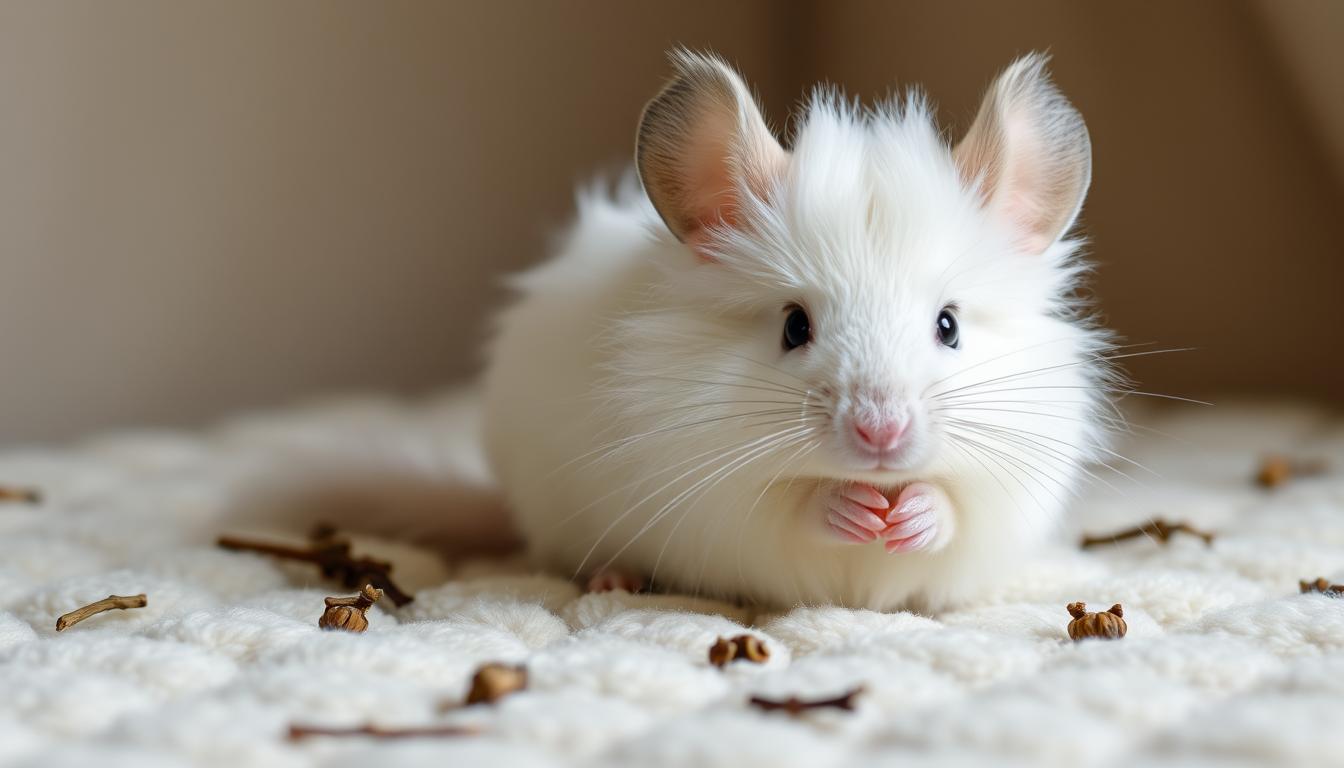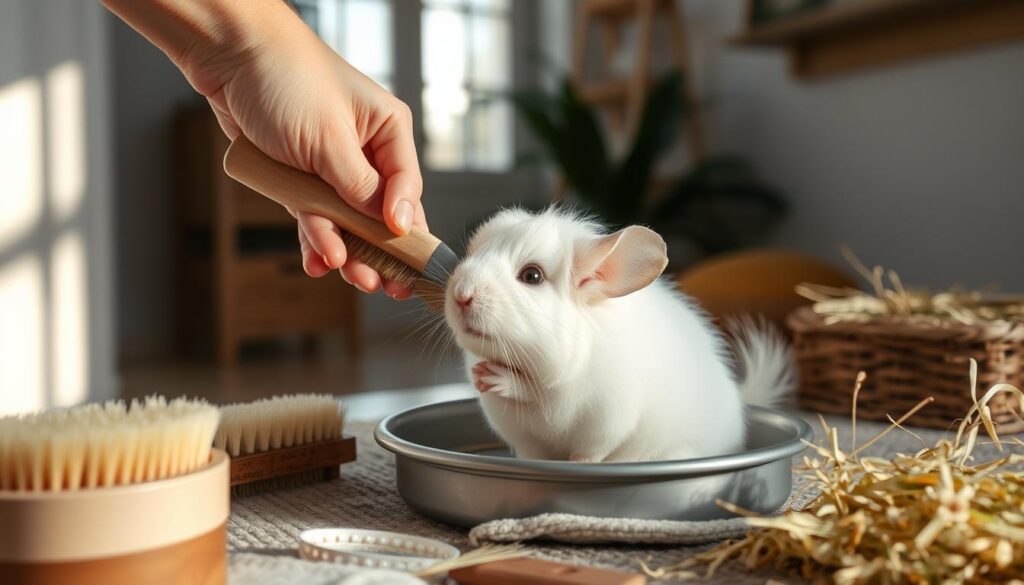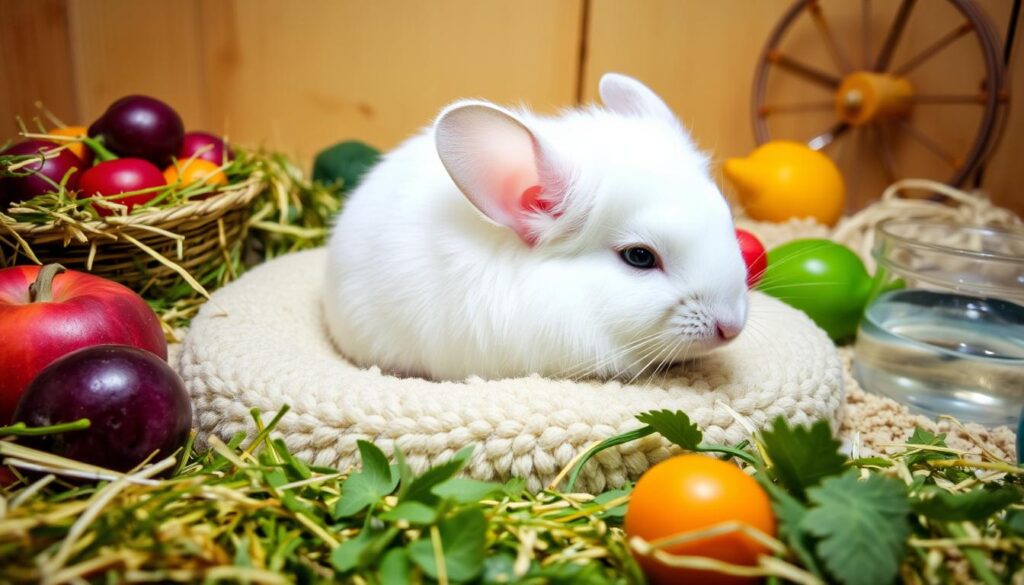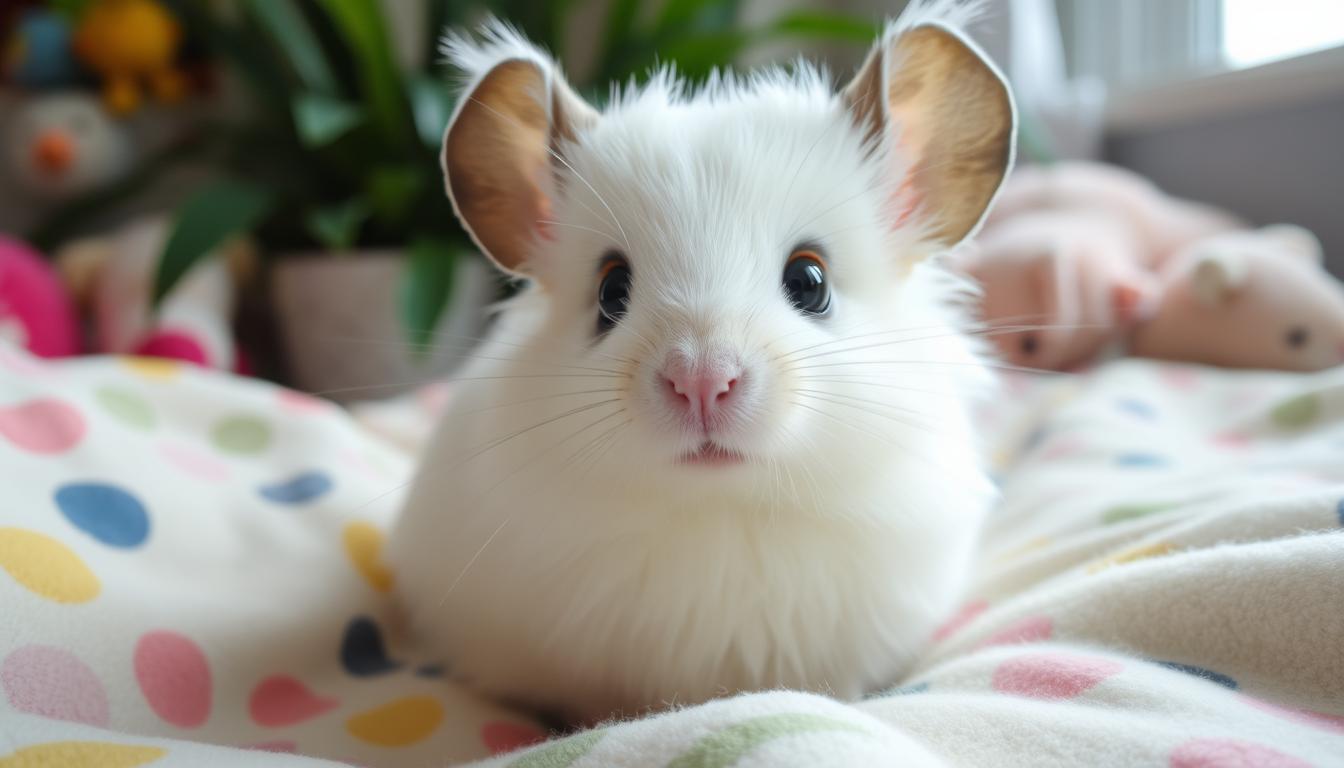Discover the Fascinating World of White Chinchillas: A Complete Guide

Thinking about getting a white chinchilla? These small rodents are loved as pets for their soft fur and fun nature. They usually weigh between 400 and 600 grams (14 to 21 ounces) when grown1. It’s important to pick a good breeder to get a healthy pet. Chinchillas like to be with others, living in groups in the wild, and can live for 10 to 15 years1.
Want to know more about white chinchillas? They have the thickest fur of any land mammal and love cooler places, best between 60°F and 70°F (15°C to 21°C)1. Learning about their needs helps you give them a great life. A good breeder can guide you in choosing the right chinchilla.
Key Takeaways
- White chinchillas are popular pets known for their soft fur and playful personalities.
- Chinchillas are social animals that thrive in groups and have a lifespan of 10 to 15 years on average1.
- Choosing a reputable white chinchilla breeder is crucial for getting a healthy pet.
- White chinchillas require a specific environment, with temperatures between 60°F and 70°F (15°C to 21°C)1.
- Understanding white chinchilla behavior and care is essential for providing the best life for your pet.
- A reputable chinchilla breeder can help you make an informed decision when selecting a white chinchilla.
- White chinchillas have the densest fur of any land mammal, making them unique and special pets1.
Introduction to White Chinchillas as Exotic Pets
Thinking about getting a white chinchilla as a pet? They need special care, like a diet full of fiber and a dust bath2. Their fur, with up to 90 hairs per follicle3, must be groomed often to avoid mats.
They need a big cage, at least 2’x2’x2′ or 8 cubic feet per animal4. Keeping them with others of the same gender is important to stop fights4. Chinchillas love company, making them great for those who want more pets2.
For your chinchilla’s health, feed them timothy hay, pellets, and sometimes dried fruit or veggies2. Regular vet visits, like exams every 6-12 months and fecal tests, are key2. With the right care, your white chinchilla will be happy and healthy.
Origins and History
Chinchillas come from the Andes Mountains in South America. They’re loved for their soft fur and calm nature, making them great pets4.
Why Choose a White Chinchilla
White chinchillas are perfect pets because of their unique look and gentle nature. They’re easy to care for, needing regular grooming and a balanced diet3. With the right care, they can bring joy and companionship to their owners.
Physical Characteristics of White Chinchillas
Understanding chinchilla information is key. White chinchillas stand out with their unique features. They are small, weighing 400 to 600 grams (14 to 21 ounces)5. They have big ears, a bushy tail, and the softest fur of any land mammal5.
A chinchilla diet is vital for their health. They need high-quality hay, limited pellets, and fresh veggies5. Chinchillas need daily care and shouldn’t be left alone for long5. They also need exercise and a warm environment, between 55-80 degrees Fahrenheit5.
Some key traits of white chinchillas include:
- Large, round ears
- Bushy tail
- Incredibly soft fur
- Small size, with adults weighing between 400 and 600 grams (14 to 21 ounces)5
Long-tailed chinchillas, like white ones, grow 9 to 14 inches long as adults6. They can weigh up to a pound6. Knowing these traits and providing the right chinchilla diet and home is crucial for their health.
The Genetics Behind White Chinchilla Coloring
Understanding the genetics of white chinchillas is key for breeders and owners. The colors of chinchillas come from many genes working together7. White chinchillas have a special gene that makes them white, with variations like White Mosaic and Silver7.
Genetic mutations cause the white variations in chinchillas. The Wilson white mutation came in 1955 in California8. It’s important to breed carefully to keep the health and quality of the offspring. Breeding animals with specific mutations should be done with caution to avoid problems8.
Different Types of White Variations
There are several white variations in chinchillas, like White Mosaic and Silver. These come from different genes working together. The colors and patterns of chinchillas can also be influenced by genes like Ebony, which affects color patterns7.
Genetic Health Considerations
Genetic health is crucial when breeding white chinchillas. Mutations like Wilson white can cause problems if not bred carefully8. Knowing the genetics helps ensure healthy and beautiful offspring. It also lets us appreciate the unique colors of these cute chinchillas.
Setting Up Your White Chinchilla’s Habitat
To keep your chinchilla healthy, setting up a good habitat is key. You’ll need a big, well-ventilated cage with chinchilla accessories like food dishes, water bottles, and hiding spots9. A cage with levels and ramps is best, letting your chinchilla climb and jump9.
The cage should be kept at a temperature between 65 to 80 degrees Fahrenheit10. Aim for a cage size of at least 4 feet by 4 feet by 3 feet, and bigger is even better10. For more tips on setting up a great habitat, check out pet care websites.
Some must-have chinchilla accessories for the cage are:
- Food dishes and water bottles
- Hiding places, such as tunnels and boxes
- Climbing structures, such as ladders and ropes
- Bedding, such as wood shavings or hay
Keep the cage clean and healthy by cleaning it often and providing fresh food and water9. By following these steps, you can make a happy and healthy home for your chinchilla.
| Accessory | Description |
|---|---|
| Food dishes | Stainless steel or ceramic dishes for food |
| Water bottles | Water bottles that can be attached to the cage |
| Hiding places | Tunnels, boxes, or other structures for hiding |
Essential Diet Requirements for Optimal Health
As a white chinchilla owner, knowing the right diet is key. A balanced diet keeps your pet healthy. Chinchilla breeders say a good diet includes hay, pellets, and a few treats. Chinchillas need about one to two tablespoons of pellets each day11.
Pellets should have 16-20% protein, 2-4% fat, and 15-20% fiber11. Hay is also important and should be given every day. Orchard grass and Timothy-grass are good choices11.
Don’t give your chinchilla more than a teaspoon of treats daily. Raisins and dried fruits are okay in small amounts, up to 3-4 times a week11. Remember, treats are often high in sugar and fat, so use them carefully11. Talking to chinchilla breeders who care about their animals’ health is a good idea.
Having a daily feeding schedule is important. Chinchillas eat most of their food in the dark12. They need different amounts of food based on their size and what they eat12.
A diet that includes hay, pellets, and a few treats helps prevent dental issues. It ensures your white chinchilla stays healthy.
Daily Care and Grooming Needs

As a white chinchilla owner, you must know their daily needs. They need regular grooming to avoid fur matting13. Dust baths are also crucial to keep their fur clean13. Chinchillas shed every three to four months, and more during seasonal changes14.
Choosing the right grooming tools is key. Use fine metal combs with sharp teeth14. Dead fur often collects at the tail base, back, and near the back legs14. Grooming can stress them, so do it only when needed14. Keep their environment under 75 degrees F, with 70 F being best15.
Here are some daily care and grooming tips:
- Provide regular dust baths to keep their fur clean and healthy13
- Use the right tools, such as fine metal combs with sharp teeth14
- Keep their enclosure clean and at a comfortable temperature15
- Monitor their health and behavior, and seek veterinary care if necessary13
By following these tips, you can ensure your white chinchilla’s happiness and health13. Always put their well-being first and seek advice if needed15.
Exercise and Entertainment Requirements
As a chinchilla owner, it’s key to give your pet enough exercise and fun. Chinchillas need 1-2 hours of playtime daily to stay healthy, just like in the wild16. You can use toys like exercise wheels, tunnels, and chew toys to keep them active.
Creating a safe and fun space is vital for your chinchilla’s happiness. Add toys and accessories, like chinchilla-friendly items, to their cage. Chinchillas love company but also need time alone to play and exercise17.
Here are some must-haves for your chinchilla’s playtime:
- Exercise wheels with a minimum diameter of 15 inches16
- Tunnels and tents for hiding and playing
- Chew toys, such as wooden or hay-based toys
- Dust baths to keep their fur clean and healthy18
Always watch your chinchilla during play to keep them safe. With the right toys and a balanced chinchilla diet, they’ll live a happy life. This ensures their overall health and happiness17.
Health Monitoring and Common Issues
As a cute chinchilla owner, knowing about common health issues is key. Chinchillas can get bladder sludge or stones, like rabbits and guinea pigs. Regular vet visits are important to keep your chinchilla healthy. Their unique needs, like their beautiful colors, must be watched closely.
Dental problems can happen if chinchillas don’t eat enough grass hay. This can cause their teeth to grow too long and lead to dental diseases19. It’s important to feed them a diet rich in fiber to keep their teeth and overall health in check.
Some common health issues in chinchillas include:
- Respiratory diseases, which can quickly turn into pneumonia if not treated20
- Gastrointestinal stasis, a serious condition that needs quick vet care20
- Skin and fur problems, like ringworm, fur chewing, and hair loss20
Regular health checks and vet visits can help catch these problems early. This ensures your cute chinchilla stays happy and healthy, with their beautiful colors shining.
Bonding With Your White Chinchilla

To bond with your white chinchilla, create a safe and comfy space. This means giving them chinchilla accessories like hide houses, toys, and scratching posts. Chinchillas, being herd animals, love to be with others21.
Building trust is key. Spend time with your chinchilla, handle them gently, and feed them well. This supports their chinchilla health. Having many food dishes and hide houses can prevent fights and make them feel safe22.
Here are some bonding tips:
- Give them a big cage for exercise and fun
- Offer lots of toys and accessories for entertainment
- Every day, spend time with them, handle them gently, and give treats
By following these steps, you can help your white chinchilla thrive. Always put their chinchilla health first. If you’re worried, talk to a vet23.
Finding Reputable White Chinchilla Breeders
When looking for a white chinchilla, finding a good breeder is key24. A good breeder knows about white chinchilla genetics and will give you a healthy, friendly pet. Tiffany, an experienced breeder, has improved her breeding to offer a variety of colors25.
Look for breeders with experience, knowledge of genetics, and a focus on animal health. Check online for reviews and ask for references25. Visiting the breeder in person helps you see how they care for their animals.
Good breeders are open about prices, which range from $300 to $500 for common colors24. They also offer health guarantees and advice on caring for your pet. By choosing a reputable breeder, you’ll get a healthy, friendly white chinchilla.
Buying a pet is a big deal, so focus on the animal’s health25. Working with a reputable breeder ensures you get a great white chinchilla for your family.
Long-term Care Commitments and Considerations
As an exotic pet owner, like those with white chinchillas, it’s key to grasp the long-term care needed. A proper environment and regular vet visits are vital for your pet’s health. White chinchilla care is crucial. They can live up to 18 years, so it’s a big commitment26.
To keep them healthy, maintain humidity levels between 40-50%27. Also, provide a stable environment with little noise and movement27.
Some important things to consider for white chinchilla care include:
- Give them a big habitat, at least 90 x 60 x 120 cm in size26
- Make sure cage bars are no more than 2.5 cm apart for good air flow26
- Feed them 1-2 tablespoons of pellets every day26
- Let them have all the high-quality hay they want, like timothy or orchard hay27
Remember, vet care for chinchillas can cost more because they’re exotic28. Regular vet visits and a good diet can prevent health problems. With the right care, your exotic pet can be a great friend for many years.
Conclusion: Creating a Happy Life for Your White Chinchilla
Starting your journey with a white chinchilla? The secret to their joy is a safe, comfy home and meeting their special needs. While chinchillas may thrive in pairs or groups, they usually prefer to be alone29. It’s not needed for them to have a friend to be happy29.
Every chinchilla is unique, with its own personality. Before getting a new friend, think if you can handle another pet29. Some chinchillas might get along, but it’s rare because of their territorial nature29. If you decide to have more, make sure they’re the same sex, unless one is fixed29.
Keep in mind, chinchillas are used to living in rocky places or holes at high elevations30. They have thick fur to stay warm in cold weather30. Give them a safe, fun space, a good diet, and lots of chances to play. This way, you’ll make your white chinchilla’s life happy and rewarding.
FAQ
What are the origins and history of white chinchillas?
Why should I choose a white chinchilla as a pet?
What are the physical characteristics of white chinchillas?
How do the genetics of white chinchillas work?
What type of habitat do white chinchillas require?
What should I feed my white chinchilla?
How do I care for and groom my white chinchilla?
What kind of exercise and entertainment do white chinchillas need?
What are some common health issues in white chinchillas?
How do I build a bond with my white chinchilla?
How do I find a reputable white chinchilla breeder?
What long-term care commitments come with owning a white chinchilla?
Source Links
- https://chinchillas-world.com/the-fascinating-world-of-chinchillas-a-comprehensive-guide/ – The Fascinating World of Chinchillas: A Comprehensive Guide – Chinchillas World
- https://www.avianexotichospital.com/chinchilla.html – Chinchilla
- http://www.exoticpetvet.com/chinchilla-care.html – Chinchilla Care
- https://www.whimsysmenagerie.com/blog/tag/personality – personality — Blog — Whimsy’s Menagerie Chinchilla Rescue
- https://qualitycage.com/blogs/news/chinchilla-colors?srsltid=AfmBOopsXlop4fes-CO_NMf4AumbhjQJ1l1oQT_adxytsszfW57dfHNw – Exploring Chinchilla Colors: How it Affects Health & More
- https://pangovet.com/pet-breeds/rodents/different-types-of-chinchillas/ – Types of Chinchilla Breeds (With Info & Pictures) | PangoVet
- https://www.sunsetchinchillas.com/Genetics.shtml – Sunset Chinchillas, Chinchilla Sales and Breeding
- https://www.sunshinechinchillas.com/chinchilla-colors-mutations – Short-tailed vs. Long-tailed
- https://www.foreverfeistychinchilla.org/chinchilla-pairs-and-bonding.html – Chinchilla Rescue | Forever Feisty Chinchilla Rescue | Emotional Health
- https://www.thesprucepets.com/chinchillas-1236769 – How to Care for a Pet Chinchilla
- https://www.thesprucepets.com/feeding-chinchillas-1238544 – What Kind of Food Should Your Chinchilla Be Eating?
- https://www.chincare.com/chinchilla-diet-what-is-the-best-chinchilla-diet/ – Chinchilla Nutrition: What is the best chinchilla diet? – ChinCare
- https://petadvocacy.org/wp-content/uploads/2022/01/Chinchilla-Care-Sheet.pdf – PDF
- https://www.chins-n-hedgies.com/threads/chinchilla-grooming.35161/ – Chinchilla Grooming
- https://chinchillaexpert.com/intro/chinchilla-care/ – Chinchilla Care 101 – Chinchilla Expert
- https://qualitycage.com/blogs/news/chinchilla-exercise?srsltid=AfmBOoqD651mFkjeyLoJ2KhnbENJ6XH6L4S89r3YQLybJ-3g4WUtuJ7- – Everything You Need to Know About Chinchilla Exercise
- https://lafeber.com/vet/basic-information-for-chinchillas/?srsltid=AfmBOooMkb90dLbxRRxdupKc4j9JNI-ieuG7ALfLlBwJTQAUfwbXxcG8 – Basic Information Sheet: Chinchilla – LafeberVet
- https://arborviewah.com/wp-content/uploads/2023/03/Chinchillas-Guide.pdf – Chinchillas Guide
- https://oxbowanimalhealth.com/blog/common-chinchilla-health-issues/ – 7 Common Chinchilla Health Issues
- https://vcahospitals.com/know-your-pet/chinchillas-diseases – Chinchillas – Heath Conditions | VCA Animal Hospitals
- https://www.chincare.com/chinchilla-introductions-and-group-dynamics/ – Introducing Chinchillas To Each Other – ChinCare
- https://chinchillaexpert.com/care-articles/behavior/chinchilla-introductions/ – How to Introduce 2 or More Chinchillas – Chinchilla Expert
- https://lychinchillas.com/tag/bonding/ – bonding – LY Chinchillas
- https://www.tiffanyschinchillas.com/chinchillas-for-sale?srsltid=AfmBOoqCgIfP3AUzMynUn35YubYQvViXi6dJ4QmFZ3uhsai_F7VOcAN1 – Chinchillas For Sale | Carolina Chinchilla
- https://www.tiffanyschinchillas.com/about-carolina-chinchilla-ranch?srsltid=AfmBOop7qvrPDDGhPRg8TQ6E8dhJ9PVl4s1GjPeNQ-QuxEgNemSXi9f5 – About Carolina Chinchilla Ranch | Carolina Chinchilla
- https://petworld.co.za/blogs/care/all-about-chinchillas-a-guide-to-your-pets-habitat-nutrition-and-well-being?srsltid=AfmBOoqjGud81QoBTRQvtRyN_-1Mi-r1lnFVLX_odXY4k9ohbNcdh_3p – All About Chinchillas: A Guide to Your Pet’s Habitat, Nutrition and We
- https://petsweekly.com/critters/caring-for-a-chinchilla/ – Caring for a Chinchilla – PetsWeekly.com
- https://www.chinchillasaspets.com/faqs.html – Chinchilla FAQs
- https://lychinchillas.com/tag/chinchilla/ – chinchilla – LY Chinchillas
- https://www.rspca.org.uk/adviceandwelfare/pets/rodents/chinchillas – Keeping Chinchillas As Pets | RSPCA – RSPCA – rspca.org.uk



